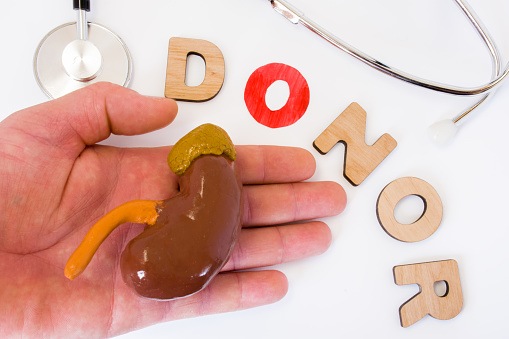
The aging of the world’s population has resulted in a dramatic increase in the prevalence of chronic kidney disease (CKD) worldwide. Further, the number of individuals receiving kidney transplantation is estimated to double by 2030. Successful transplantation reduces the mortality rate associated with end-stage kidney disease, and advances in immunosuppression therapy have improved short-term graft survival and reduced the risk of mortality among kidney transplant recipients.
However, according to Takuya Ohata, PT, MS, and colleagues, the rate of long-term graft survival has not yet reached a satisfactory level. Declines in estimated glomerular filtration rate (eGFR) following kidney transplantation are strongly linked to premature mortality as well as the incidence of graft failure.
Physical activity is a recognized modifiable lifestyle factor for patients with CKD. Previous studies have suggested that physical activity has beneficial effects on health-related outcomes in kidney transplant recipients. However, there are few data available on the effects of the type or intensity of physical activity and sedentary behavior on eGFR in that patient population. The researchers conducted a study designed to clarify the association between accelerometry-measured PA and sedentary behavior and eGFR in kidney transplant recipients. Results were reported in the Journal of Renal Nutrition.
Physical activity before renal transplant was retrospectively measured using the International Physical Activity Questionnaire Short Form; the value was used as a covariable in the statistical analyses. The total physical activity was then calculated and presented as metabolic equivalents (METs) per minute per week.
All participants wore a triaxial accelerometer to measure physical activity for 24 hours per day over 10 consecutive days. Proprietary software packages were used to download the data from the accelerometers to quantify physical activity. For the data to be considered valid, at least 7 consecutive days within a 24-hour period of wear time per day were required. Within the valid period, any constitutive 7-day data were extracted for further analyses. Measured physical activity was classified based on intensity: (1) light physical activity; (2) moderate-to-vigorous physical activity; and (3) sedentary behavior.
Multiregression analyses of single-factor, partition, and isotemporal substitution models were used to examine the association of each type of physical activity with eGFR. The isotemporal model was applied to examine the estimated effects of substituting 30 minutes of sedentary behavior with an equal amount of light physical activity or moderate-to-vigorous physical activity on eGFR. Physical function was evaluated using four measures: (1) grip strength, assessed using a grip strength meter; (2) knee extensor muscle strength, measured using a handheld dynamometer; (3) gait speed, measured twice using a digital stopwatch; and (4) 6-minute walking test, evaluated according to the American Thoracic Society guidelines.
The cross-sectional study included 82 kidney transplant outpatients. Of those, 65 were included in the final analyses. Average age of the 65 included patients was 56.9 years, 58.5% (n=38) were men, and mean body mass index was 21.7 kg/m2. Mean time post-transplant was 83.0 months, and 63% (n=41) underwent dialysis prior to transplant. Comorbidities included diabetes (18.5%, n=12), hypertension (44.6%, n=29), dyslipidemia (12.3%, n=8), and hyperuricemia (6.2%, n=4). Mean eGFR at baseline was 42.5 mL/min/1.73 m2.
Immunosuppression medications included calcineurin inhibitors (tacrolimus or cyclosporine, 98.5%, n=64), antiproliferative agents (mycophenolate mofetil or azathioprine, 96.9%, n=63), mTOR (mammalian target of rapamycin) inhibitor (everolimus, 50.8%, n=33), and steroids (prednisone, 100%, n=65).
In multiple regression analyses, eGFR could be explained by sedentary behavior and moderate-to-vigorous physical activity. In the partition model, there was a positive association between moderate-to-vigorous physical activity and eGFR (P<.05). There was no positive association between sedentary behavior or light physical activity and eGFR. The isotemporal substitution model demonstrated that substituting time spent in sedentary behavior with moderate-to-vigorous physical activity led to beneficial changes in eGFR (P<.05). There was no significant improvement in eGFR substituting sedentary behavior with light physical activity.
The authors cited some limitations to the study findings, including the nonprospective and noninterventional design of the study, creating the possibility of biases that prevented the identification of the cause-and-effect relationship between physical activity and eGFR; not adjusting the statistical analyses for the renal function of the study population immediately following transplantation or for dietary data; and the small sample sizes for the subgroup analyses.
In conclusion, the researchers said, “The present study suggested that moderate-to-vigorous physical activity was an independent explanatory variable for eGFR in renal transplant recipients and replacing 30 minutes of sedentary behavior with moderate-to-vigorous physical activity after renal transplantation might lead to the maintenance or improvement of eGFR in renal transplant recipients.”
Source: Journal of Renal Nutrition







 © 2025 Mashup Media, LLC, a Formedics Property. All Rights Reserved.
© 2025 Mashup Media, LLC, a Formedics Property. All Rights Reserved.